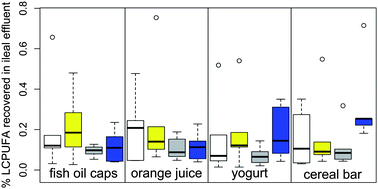Omega-3 fatty acids in ileal effluent after consuming different foods containing microencapsulated fish oil powder – an ileostomy study
Abstract
The intestinal absorption of omega-3 long chain

Maintenance work is planned for Wednesday 1st May 2024 from 9:00am to 11:00am (BST).
During this time, the performance of our website may be affected - searches may run slowly and some pages may be temporarily unavailable. If this happens, please try refreshing your web browser or try waiting two to three minutes before trying again.
We apologise for any inconvenience this might cause and thank you for your patience.
* Corresponding authors
a
CSIRO Preventative Health National Research Flagship, Australia
E-mail:
luz.sanguansri@csiro.au
Fax: +61-3-97313250
Tel: +61-3-97313228
b CSIRO Animal, Food and Health Sciences, 671 Sneydes Road, Werribee, Victoria 3030, Australia
c CSIRO Mathematics Informatics and Statistics, PMB 2, Glen Osmond, SA 5064, Australia
d CSIRO Animal, Food and Health Sciences, 11 Julius Avenue, North Ryde, NSW 2113, Australia
The intestinal absorption of omega-3 long chain

 Please wait while we load your content...
Something went wrong. Try again?
Please wait while we load your content...
Something went wrong. Try again?
L. Sanguansri, Z. Shen, R. Weerakkody, M. Barnes, T. Lockett and M. A. Augustin, Food Funct., 2013, 4, 74 DOI: 10.1039/C2FO30133D
To request permission to reproduce material from this article, please go to the Copyright Clearance Center request page.
If you are an author contributing to an RSC publication, you do not need to request permission provided correct acknowledgement is given.
If you are the author of this article, you do not need to request permission to reproduce figures and diagrams provided correct acknowledgement is given. If you want to reproduce the whole article in a third-party publication (excluding your thesis/dissertation for which permission is not required) please go to the Copyright Clearance Center request page.
Read more about how to correctly acknowledge RSC content.
 Fetching data from CrossRef.
Fetching data from CrossRef.
This may take some time to load.
Loading related content
